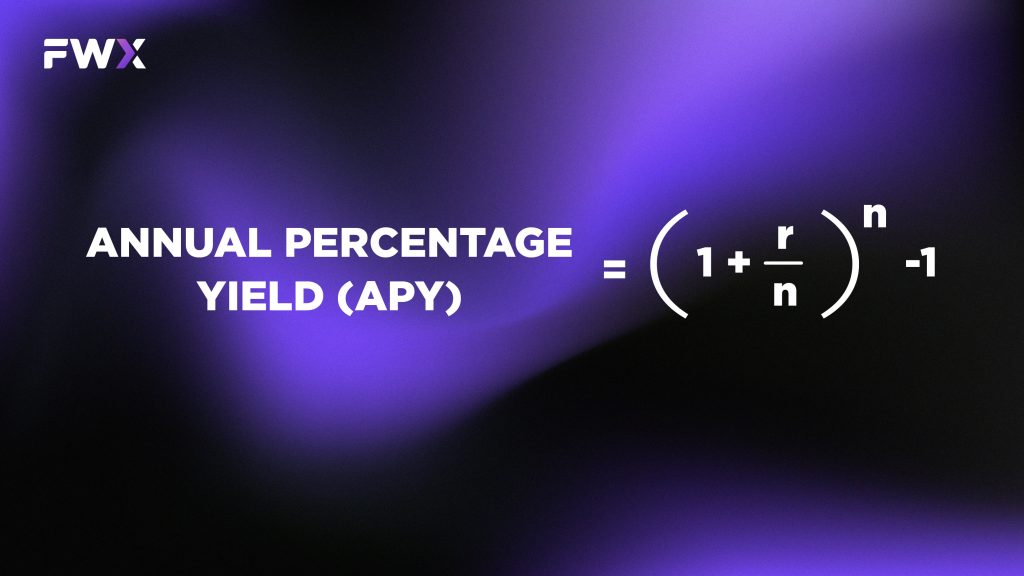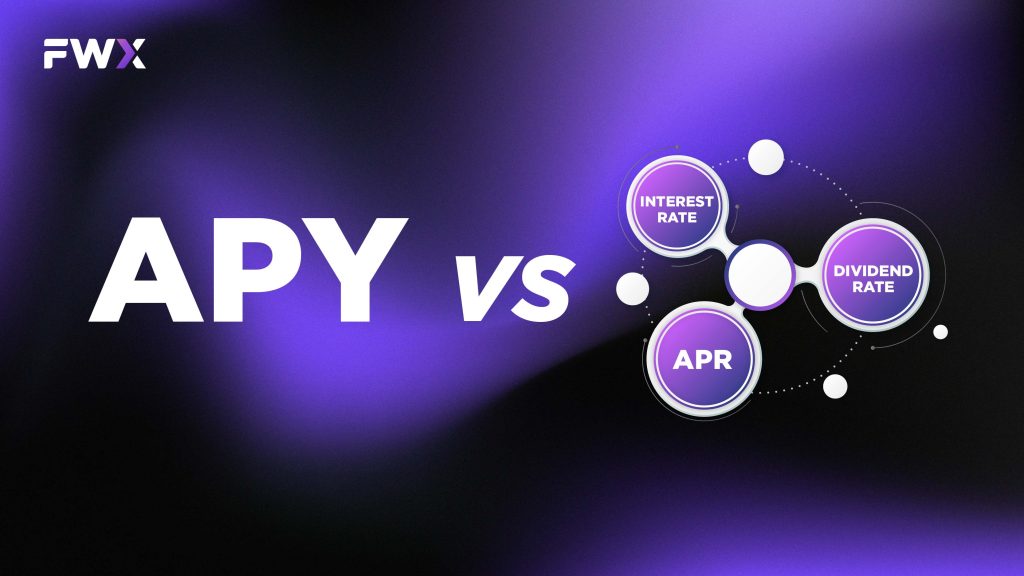Annual Percentage Yield, commonly known as APY, is a financial term used to describe the annual return on an investment, expressed as a percentage of the initial investment. APY is an essential concept in both traditional finance and the world of cryptocurrencies, especially in decentralized finance (DeFi), helping investors to compare the potential returns of different investment options. Here, we will delve into the definition, calculation, and practical applications of APY, providing a comprehensive understanding of this important financial metric.
What is APY?

In traditional finance, APY is a standard measure of the interest earned on an investment for a year, represented as a percentage of the initial investment. It can refer to the fact that the APY measures the effective annual rate of return on an investment carrying into account any compounding interest that affects the return. In the crypto world, APY is a similar measure of the return on investment for cryptocurrency assets.
One of the major differences between traditional finance and crypto world is that APY in the crypto world is crucial to mention that APY in crypto can be highly volatile and subject to market fluctuations, which can significantly influence the amount of returns investors earn. Besides, different platforms and protocols may offer different APY rates and terms, so it is essential to conduct thorough research before making investment decisions.
However, APY is one of the most popular measures that helps investors compare the potential returns of their portfolio in the crypto space.
How to earn APY in the crypto world?

Staking is one of the main methods for investors to earn APY in the crypto space. Staking involves holding a specific amount of cryptocurrency in a wallet or on a platform to help safeguard the network and verify transactions. Stakers can receive rewards in the form of extra tokens in exchange for providing this service. These rewards add up to the total APY for the investment.
Another way to earn APY in crypto is via lending or borrowing. Certain platforms offer lending or borrowing services, enabling users to deposit or borrow cryptocurrency assets with interest rates applied to both sides of the transaction. Lenders can earn interest on the deposited amount, while borrowers have to pay interest on the borrowed amount. The APY for such investments can fluctuate depending on market conditions and the need for lending or borrowing.
Furthermore, providing liquidity to decentralized exchanges is also an optional investment to obtain APY. This is done by depositing two different cryptocurrencies in equal amounts into a liquidity pool. In return, users can receive trading fees and any protocol rewards as compensation for providing liquidity. This process is also known as liquidity mining.
For very reasons, it is important to note that the APY of cryptocurrency investment can vary widely depending on the market conditions. Also, it is essential to consider the risks associated with cryptocurrency investments, such as market volatility, regulatory uncertainty, and security risks.
APY formula

APY is typically calculated based on the initial investment amount and the annualized rate of return, which considers any rewards or interest earned for a year. For example, if an investor invests $100 in a cryptocurrency that offers a 10% APY, he will make $10 in interest for the year, resulting in a total portfolio value of $110. It means that the investment will earn 10% per year on the initial investment, including any compounding. Nevertheless, if the platform uses a nominal annual interest rate for a year, the investor, who needs to calculate the interest for compounding periods in one year, needs to compare the rate to APY before calculating the total portfolio value.
Given the investor knows the nominal annual interest rate (represented by r) and the number of compounding periods in one year (represented by n). The formula to calculate APY with respect to the nominal annual interest rate (r) is
APY = (1 + r/n)^n – 1
Let’s use an example to illustrate how to calculate APY. If the investor invests in a cryptocurrency asset that has an annual interest rate of 10%, the calculation of APY will be:
- Compounded semi-annually (n = 2)
APY = (1 + 10%/2)^(2) – 1 = 0.1025 or 10.25%,
- Compounded quarterly (n = 4)
APY = (1 + 10%/4)^(4) – 1 = 0.1038 or 10.38%,
- Compounded monthly (n = 12)
APY = (1 + 10%/12)^(12) – 1 = 0.1047 or 10.47%,
- Compounded daily (n = 365)
APY = (1 + 10%/365)^(365) – 1 = 0.1051 or 10.51%,
- Compounded continuously (n approaches to infinity)
APY = (1 + 10%/n)^(n) – 1 = e^(0.1) – 1 = 0.1052 or 10.52%.
The compounding frequency of an investment can significantly impact the APY. The more frequently the interest or rewards are compounded, the higher the APY. Conversely, the lower APY, the lower the compounding frequency is. Therefore, carefully considering the compounding frequency when evaluating different investment opportunities is vital.
APY vs Other metrics

In addition to APY, there are a number of the other metrics that are commonly used in the crypto space:
- ROI (Return on Investment): ROI is a measure of the profit or loss generated by an investment relative to the initial cost of the investment. It is usually expressed as a percentage and is calculated by subtracting the initial investment from the final investment value, dividing that result by the initial investment, and multiplying by 100. ROI is a valuable metric for evaluating the overall profitability of an investment.
- APR (Annual Percentage Rate): APR measures the interest rate charged for borrowing or lending money for a year. It does not consider the effects of compounding and is commonly used for loans, credit cards, and other financial products.
- CAGR (Compound Annual Growth Rate): CAGR measures an investment’s average annual growth rate over a specified period, taking into account the effects of compounding. It is calculated by dividing the final investment value by the initial investment value, taking the nth root of that value, and then subtracting 1, where n is the number of years of the investment period. CAGR is a valuable metric for evaluating the long-term performance of an investment.
While these metrics are helpful and each of these metrics has its own strengths and weaknesses, they are not interchangeable and should be used for different purposes. For example, APY is useful for evaluating the returns of investments that offer rewards or interest payments, while ROI helps evaluate the overall profitability of an investment. Likewise, APR is useful for evaluating the costs of borrowing or lending money, and CAGR helps evaluate the long-term performance of an investment.
It is also important to note that these metrics do not guarantee future returns, and investments in cryptocurrency are inherently risky and subject to market fluctuations. Therefore, investors should carefully consider their investment goals, risk, and other factors before making investment decisions.
APY vs Interest rate
An interest rate is the amount of money a lender charges a borrower to use their funds. It is usually expressed as an annual percentage rate (APR) applied to loans or deposits. The interest rate reflects the cost of borrowing money and the reward for lending money.
On the other hand, APY measures the total interest an investment will earn in a year, considering the effects of compounding. It is expressed as a percentage and includes any fees or interest associated with the investment. APY is a more comprehensive measure of the total earnings of the investment, whereas an interest rate only reflects the cost of borrowing or the reward for lending.
In summary, interest rate and APY are related but different concepts. Interest rate deliberates the cost of borrowing or the interest for lending, while APY is a more comprehensive measure of the total returns of an investment, taking into account the effects of compounding and any associated fees or rewards.
APY vs APR
APR and APY are two financial metrics commonly used to quantify the cost or return on investment, but they differ in terms of what they measure and their respective applications. APR denotes the annual interest rate charged on loans, credit cards, or any form of borrowing, representing the cost of borrowing money. It includes only the interest rate and any associated fees but does not consider the impact of compounding. Conversely, APY measures the annual rate of return on investment, considering the impact of compounding and any fees or rewards linked to the investment. It is expressed as a percentage and is utilized to compare the potential returns of different investment options. The fundamental contrast between APR and APY is that APR describes the cost of borrowing, whereas APY is used to evaluate the potential return on investment. In summary, APR and APY are crucial financial measures, but they have different applications and measure distinct aspects of a financial transaction. Let’s see the following examples to clarify the difference.
For example, if you borrow $100 at an APR of 5%, you will be charged $5 in interest over the course of a year.
For example of APY, if you invest $100 in a cryptocurrency with a 5% APY, you will earn $5 in interest over the course of a year, but if that investment also includes a 1% reward for staking, your APY will be 6% for the year.
APY vs Dividend rate
Although APY and dividend rate are used to evaluate investment performance, they differ in their computation and usage. APY is based on the investment’s total value, while Dividend Rate is based on the company’s stock price and dividends paid out.
To summarize, APY and dividend rate are two specific measures used in evaluating investments. APY measures the total return of an investment, while dividend rate measures the percentage of a company’s stock price paid out as dividends to its shareholders.
For example, an investor is considering two investment opportunities: plan A offers an APY of 5%, while plan B offers a dividend rate of 3%. Let us examine each plan in more detail to understand these two measures’ differences.
For plan A, an APY of 5%, investing $100 in plan A will result in earning $5 in interest over one year. This calculation is based on multiplying the initial investment of $100 by the APY of 5%. It is essential to understand that APY factors in the compounding effect, which means that the earned interest is added to the principal amount, and interest is earned on that new total. This compounding effect makes APY higher than the simple interest rate.
For plan B, a dividend rate of 3%, investing $100 in plan B will result in receiving $3 in dividends over one year. This calculation is based on multiplying the initial investment of $100 by the dividend rate of 3%. It is important to note that not all companies pay dividends, and the amount paid out can vary based on the company’s financial performance. Moreover, the company’s stock price can change, which can also affect the dividend rate.
Conclusion
APY is a popular measure used in both traditional finance and the crypto world to evaluate the potential returns of an investment over a year. However, in the crypto world, APY can be highly volatile and subject to market fluctuations, and different platforms may offer different rates and terms. It is crucial to conduct thorough research before making investment decisions.
APR and APY are two important financial metrics that measure different aspects of a financial transaction. APR represents the cost of borrowing money, including the interest rate and any associated fees, while APY measures the potential return on investment, considering the impact of compounding and any fees or rewards linked to the investment.
In summary, APR and APY are crucial financial measures that serve different purposes and measure distinct aspects of a financial transaction. It is important to consider both when making financial decisions and to conduct thorough research before investing or borrowing money.


